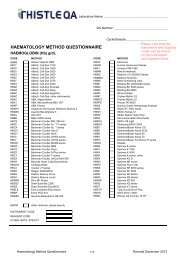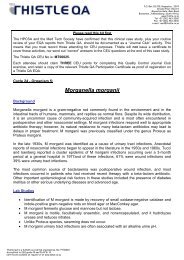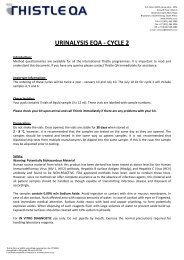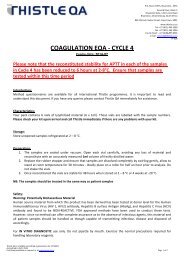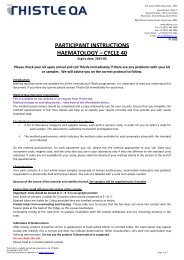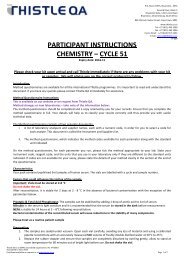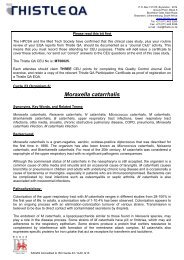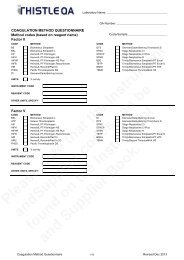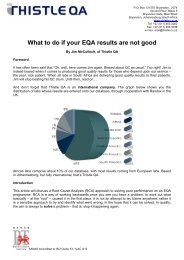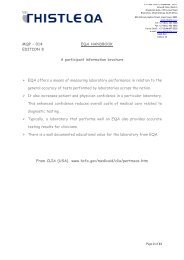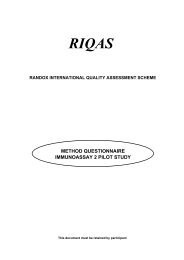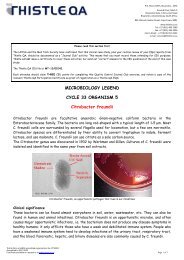Creatine kinase (CK) - Thistle QA
Creatine kinase (CK) - Thistle QA
Creatine kinase (CK) - Thistle QA
Create successful ePaper yourself
Turn your PDF publications into a flip-book with our unique Google optimized e-Paper software.
P.O. Box 131375, Bryanston, 2074Ground Floor, Block 5Bryanston Gate, Main RoadBryanston, Johannesburg, South Africawww.thistle.co.zaTel: +27 (011) 463-3260Fax: +27 (011) 463-3036e-mail : mail@thistle.co.zaPlease read this bit firstThe HPCSA and the Med Tech Society have confirmed that this clinical case study, plus your routine review of your E<strong>QA</strong>reports from <strong>Thistle</strong> <strong>QA</strong>, should be documented as a “Journal Club” activity. This means that you must record thoseattending for CEU purposes. <strong>Thistle</strong> will not issue a certificate to cover these activities, nor send out “correct” answersto the CEU questions at the end of this case study.The <strong>Thistle</strong> <strong>QA</strong> CEU No is: MT00025.Each attendee should claim THREE CEU points for completing this Quality Control Journal Club exercise, and retain acopy of the relevant <strong>Thistle</strong> <strong>QA</strong> Participation Certificate as proof of registration on a <strong>Thistle</strong> <strong>QA</strong> E<strong>QA</strong>.CHEMISTRY LEGENDAugust 2009<strong>Creatine</strong> <strong>kinase</strong> (<strong>CK</strong>)<strong>Creatine</strong> <strong>kinase</strong> (<strong>CK</strong>), also known as <strong>Creatine</strong> phospho<strong>kinase</strong> (CPK) or phospho-creatine <strong>kinase</strong> orsometimes wrongfully also creatinine <strong>kinase</strong>, is an enzyme expressed by various tissues and celltypes. <strong>CK</strong> catalyses the conversion of <strong>Creatine</strong> and consumes adenosine triphosphate (ATP) tocreate phospho-creatine (PCr) and adenosine diphosphate (ADP). This <strong>CK</strong> enzyme reaction isreversible, such that also ATP can be generated from PCr and ADP.In tissues and cells that consume ATP rapidly, especially skeletal muscle, but also brain,photoreceptor cells of the retina, hair cells of the inner ear, spermatozoa and smooth muscle,phospho-creatine serves as an energy reservoir for the rapid buffering and regeneration of ATP insitu, as well as for intracellular energy transport by the phospho-creatine shuttle or circuit. Thus<strong>Creatine</strong> <strong>kinase</strong> is an important enzyme in such tissues.Clinically, <strong>Creatine</strong> <strong>kinase</strong> is assayed in blood tests as a marker of myocardial infarction (heartattack), rhabdomyolysis (severe muscle breakdown), muscular dystrophy, and in acute renal failure.TypesIn the cells, the "cytosolic" <strong>CK</strong> enzymes, consists of two subunits, which can be either B (braintype) or M (muscle type). There are, therefore, three different isoenzymes: <strong>CK</strong>-MM, <strong>CK</strong>-BB and<strong>CK</strong>-MB. In addition to those three cytosolic <strong>CK</strong> isoforms, there are two mitochondrial <strong>Creatine</strong><strong>kinase</strong> isoenzymes, the ubiquitous and sarcomeric form. While mitochondrial <strong>Creatine</strong> <strong>kinase</strong> is<strong>Thistle</strong> <strong>QA</strong> is a SANAS accredited organisation, No: PTS0001Accredited to ISO guide 43 and ILAC G13Certificate available on request or at www.sanas.co.za
P.O. Box 131375, Bryanston, 2074Ground Floor, Block 5Bryanston Gate, Main RoadBryanston, Johannesburg, South Africawww.thistle.co.zaTel: +27 (011) 463-3260Fax: +27 (011) 463-3036e-mail : mail@thistle.co.zadirectly involved in formation of phospho-creatine from mitochondrial ATP, cytosolic <strong>CK</strong>regenerate ATP from ADP, using PCr. This happens at intracellular sites where ATP is used in thecell, with <strong>CK</strong> acting as an in situ ATP regenerator.gene<strong>CK</strong>B<strong>CK</strong>BE<strong>CK</strong>Mproteincreatine <strong>kinase</strong>, brain, BB-<strong>CK</strong>creatine <strong>kinase</strong>, ectopic expressioncreatine <strong>kinase</strong>, muscle, MM-<strong>CK</strong><strong>CK</strong>MT1A, <strong>CK</strong>MT1B creatine <strong>kinase</strong> mitochondrial 1; ubiquitous mt<strong>CK</strong>; or u mt<strong>CK</strong><strong>CK</strong>MT2creatine <strong>kinase</strong> mitochondrial 2; sarcomeric mt<strong>CK</strong>; or s mt<strong>CK</strong>Isoenzyme patterns differ in tissues. <strong>CK</strong>-BB occurs mainly in brain tissue, and its levels rarely hasany significance in the bloodstream. <strong>CK</strong>-BB expressed also in all tissues at low levels has littleclinical relevance. Skeletal muscle expresses <strong>CK</strong>-MM (98%) and low levels of <strong>CK</strong>-MB (1%). Themyocardium (heart muscle), in contrast, expresses <strong>CK</strong>-MM at 70% and <strong>CK</strong>-MB at 25–30%.<strong>CK</strong> is one of the “cardiac” enzymes and is used mainly for the diagnosis and evaluation of myocardialinfarction. However before a diagnosis of acute myocardial infarction can be made, two of thefollowing 3 criteria must be met. (WHO 1971 – 1972):1. A history of chest pain consistent with myocardial ischaemia2. ECG changes consistent with myocardial infarction3. Typical myocardial infarction plasma enzyme changes e.g. total <strong>CK</strong> twice the upperreference limit or increased to at least three times the initial valueCommon causes of increased plasma <strong>CK</strong> activityCardiac muscle Skeletal muscle MiscellaneousMyocardial infarction Muscular dystrophy HypothyroidismMyocarditis Myoglobinuria Cerebrovascular accidentsDermatomyositisHyper/hypothermiaGeneralized convulsions Diabetic ketoacidosisSevere exerciseSepticaemiaMuscle traumaMalignancyMyopathy: alcoholic Immunoglobulin-<strong>CK</strong>complexesIntramuscular injectionThe majority of these disorders are usually evident clinically and generally there is no problemdetermining the cause of the high enzyme level. However, there are two situations where furtherinvestigations may be necessary to determine the tissue of origin:<strong>Thistle</strong> <strong>QA</strong> is a SANAS accredited organisation, No: PTS0001Accredited to ISO guide 43 and ILAC G13Certificate available on request or at www.sanas.co.za
P.O. Box 131375, Bryanston, 2074Ground Floor, Block 5Bryanston Gate, Main RoadBryanston, Johannesburg, South Africawww.thistle.co.zaTel: +27 (011) 463-3260Fax: +27 (011) 463-3036e-mail : mail@thistle.co.za1. A patient with a raised plasma <strong>CK</strong> due to non-cardiac diseases (e.g. skeletal muscle damage), whohas chest pain and in whom the ECG is unhelpful in diagnosis.2. A patient with an isolated elevated <strong>CK</strong> level in whom the cause is not obvious clinically.In the first situation the problem can usually be resolved by measuring the <strong>CK</strong> isoenzymes.However there are two important points to bear in mind when interpreting <strong>CK</strong> isoenzymemeasurements:1. Cardiac muscle consists mainly of <strong>CK</strong>-MM and less than 15% of <strong>CK</strong>-MB; skeletal muscle is mostly<strong>CK</strong>-MM but contains 1% <strong>CK</strong>-MB. Thus, very high levels of plasma <strong>CK</strong> activity due to skeletal muscledamage will show quite high absolute levels <strong>CK</strong>-MB, but the proportion of <strong>CK</strong>-MB will still be lessthan 1-2%.2. There are a number of diseases, unrelated to cardiac or skeletal muscle, which can be associatedwith high plasma levels of <strong>CK</strong>-MB; e.g. malignancy, septicaemia. In such cases the increased plasma<strong>CK</strong> may represent an immunoglobulin-<strong>CK</strong> complex.Case StudyA 61 year old woman presented with back and chest pain for investigation. She had three episodesof central stabbing chest pain over the past year. The pain did not radiate down her arms and wasthought to be atypical for myocardial ischaemia. Her medication on admission included clofibratefor hypercholesterolaemia. On examination she revealed a slow manner and speech, and a shortunsteady gait. Her blood pressure was 150/90 and pulse rate 70. Her plasma electrolyte valuesand liver function tests were normal, but she had abnormally high plasma <strong>CK</strong> and LD activities:Plasma <strong>CK</strong> 6098 U/L (30 – 140)Plasma LDH 654 U/L (85 – 180)Differential DiagnosisThe history of chest pain and hypercholesterolaemia, coupled with high plasma <strong>CK</strong>, suggested thepossibility of cardiac disease and she was given a provisional diagnosis of myocardial infarction.References1. Cases in chemical pathology – A Diagnostic approach 4 th edition2. Fundamentals of Clinical Chemistry 3 rd edition – NW TietzQuestions1. Discuss the different types of <strong>CK</strong> enzymes and isoenzymes.2. According to WHO, what criteria must first be met before a diagnosis of Myocardial infarctioncan be made?3. Discuss the common causes of an increased plasma <strong>CK</strong> activity?<strong>Thistle</strong> <strong>QA</strong> is a SANAS accredited organisation, No: PTS0001Accredited to ISO guide 43 and ILAC G13Certificate available on request or at www.sanas.co.za



